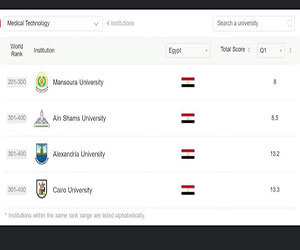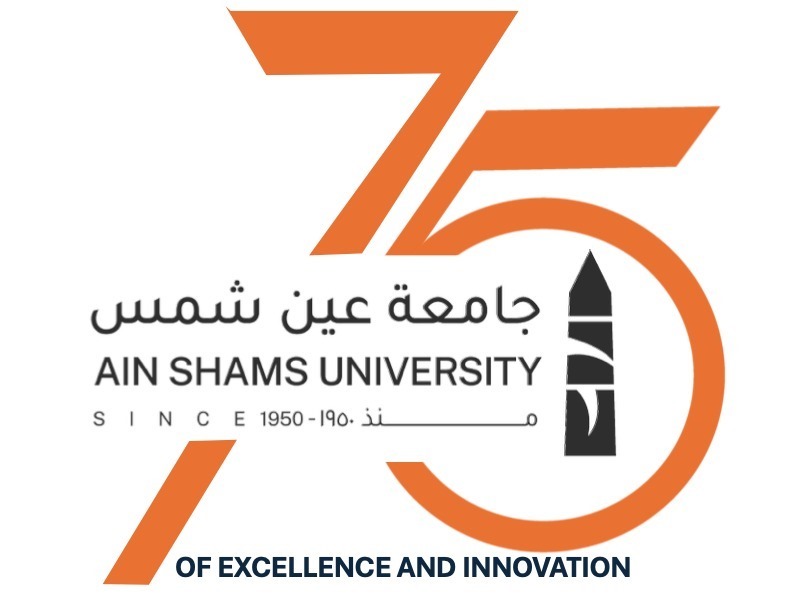The inclusion of five Egyptian universities in the Shanghai 2020 classification, including Ain Shams University
Dr. Khaled Abdel Ghaffar, Minister of Higher Education and Scientific Research, received a report on the inclusion of five Egyptian universities in the Shanghai classification for the year 2020, which are universities: Cairo ranked (401-500), followed by Alexandria (701-800), Ain Shams (801-900), Mansoura ( 801-900), Zagazig (901-1000), and the report indicated the emergence of 15 Egyptian universities in some scientific disciplines in the medical, natural sciences, engineering, life sciences and social sciences with this classification, which are: (Cairo, Alexandria, Ain Shams, Mansoura, Zagazig, Assiut, Aswan, Al-Azhar, Beni Suef, Suez Canal, Kafr El-Sheikh, Fayoum, Minya, Sadat City, British University in Egypt).

In the medical sciences sector:
Clinical Medicine: Mansoura University ranked (201-300), Ain Shams (301-400), Cairo (301-400), and Alexandria (401-500).
Dentistry: Ain Shams, Cairo and Mansoura universities participated in the center (201-300).
Medical Science Technology: Mansoura University topped the Egyptian universities with a rank (201-300), followed by three Egyptian universities: Ain Shams, Cairo and Alexandria in the position (301-400).
Pharmacy sector: 11 Egyptian universities appeared, where Cairo University topped the position (151-200), followed by the universities of Ain Shams, Al-Azhar, Alexandria, Beni Suef, Kafr El-Sheikh and Mansoura in the position (201-300), then the universities of Assiut, Minya, Suez Canal and Zagazig in the position (401- 500).
Public Health: Cairo University advanced in the position (101-150), followed by Mansoura University in the position (201-300), then Ain Shams University in the position (301-400).
In the natural sciences sector:
Mathematics Sciences: Cairo University ranked (201-300), followed by Mansoura University (301-400).
Physics: The British University in Egypt appeared in the position (301-400), followed by Fayoum University in the position (401-500).
In the engineering sciences sector:
Biotechnology Sciences: Alexandria, Cairo, and Zagazig universities ranked (401-500).
Chemistry: Cairo University topped the place (401-500).
Civil Engineering: Cairo University ranked (201-300).
Computer Science: Zagazig University topped the position (301-400), followed by Cairo and Mansoura universities (401-500).
In Electrical Engineering: Assiut and Zagazig Universities ranked in the position (301-400), and Aswan and Cairo Universities ranked (401-500).
Energy Sciences: Assiut and Cairo Universities ranked (301-400).
Mechanical Engineering: Cairo and Zagazig Universities appeared in the position (301-400).
In the life sciences sector: Agricultural Engineering: Kafrelsheikh University ranked (201-300), followed by Zagazig University (301-400), then Cairo, Mansoura and Tanta universities (401-500).
Human Biology: Kafrelsheikh University appeared in the position (401-500).
Plant sciences: 10 Egyptian universities advanced, where Beni Suef, Mansoura and Zagazig universities ranked (101-150), followed by the universities of Alexandria, Cairo and Kafr El-Sheikh (151-200), then the universities of Benha, Damanhour, Suez Canal and Sadat in the position (201-300).
In the social sciences sector:
Business Administration: Cairo University ranked (401-500).
Dr. Adel Abdel Ghaffar, media advisor and official spokesperson for the ministry, stated that the international rankings of universities depend on different variables in the evaluation. The Shanghai classification depends on several criteria: the number of university graduates who won the Nobel Prize (10%), the number of faculty staff who won the Nobel Prize (20%). ), the number of highly citation scientists (20%), the number of papers included in Clarvet databases (20%), the number of papers published in Nature journals (20%), the balance in faculty staff in different science sectors (10%), and the Simago rating ( The Spanish Scimago is concerned with ranking universities and research centers according to a composite index that combines three different indicators based on research performance (50%), innovation outputs (30%), and societal impact (20%). Each major indicator includes a number of sub-indicators, provided that The Foundation publishes at least 100 papers in the SCOPUS database in the year of the assessment.
While the British Times classification is based on evaluating the best international universities according to 5 areas: teaching (30%), scientific research (30%), citations (30%), industrial links (2.5%), international theory (7.5%) through 13 A performance indicator related to teaching, research, knowledge transfer, and international questionnaires that provide the most comprehensive and balanced comparisons between universities, provided that universities conduct the teaching process for students, and that their research output is not less than 1,000 research during the period 2015-2019 and a minimum of 150 research papers per year. Universities are also excluded from entering this classification is if 80% or more of its research outputs fall into one of the eleven disciplines defined in the classification. We find that the US NEWS classification is based on several criteria, including: the academic success of universities, the reputation of global and regional research, the volume of international cooperation, and doctoral grants. As for the (QS) global ranking, it depends on many criteria, including (academic reputation, professor-student ratio, academic research, international professors ratio, and international students ratio).
Dr. Adel Abdel Ghaffar added that the progress of Egyptian universities in the various international classifications is due to several measures that took place during the past period, the most important of which are: the technical support provided by the Ministry of Higher Education and Scientific Research to Egyptian universities, as well as training in international publishing, in addition to what universities are doing to motivate researchers in all Academic degrees for publication in prestigious international journals, and the distinguished ratings granted to internationally published scientific research in the work of scientific promotion committees.


.svg)




